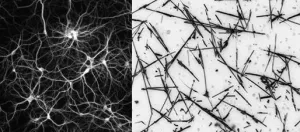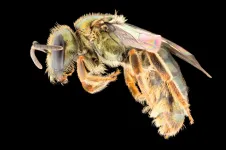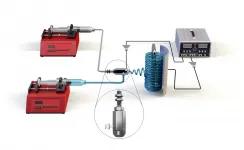(Press-News.org) Scientists at the University of Sydney and Japan's National Institute for Material Science (NIMS) have discovered that an artificial network of nanowires can be tuned to respond in a brain-like way when electrically stimulated.
The international team, led by Joel Hochstetter with Professor Zdenka Kuncic and Professor Tomonobu Nakayama, found that by keeping the network of nanowires in a brain-like state "at the edge of chaos", it performed tasks at an optimal level.
This, they say, suggests the underlying nature of neural intelligence is physical, and their discovery opens an exciting avenue for the development of artificial intelligence.
The study is published today in Nature Communications.
"We used wires 10 micrometres long and no thicker than 500 nanometres arranged randomly on a two-dimensional plane," said lead author Joel Hochstetter, a doctoral candidate in the University of Sydney Nano Institute and School of Physics.
"Where the wires overlap, they form an electrochemical junction, like the synapses between neurons," he said. "We found that electrical signals put through this network automatically find the best route for transmitting information. And this architecture allows the network to 'remember' previous pathways through the system."
ON THE EDGE OF CHAOS
Using simulations, the research team tested the random nanowire network to see how to make it best perform to solve simple tasks.
If the signal stimulating the network was too low, then the pathways were too predictable and orderly and did not produce complex enough outputs to be useful. If the electrical signal overwhelmed the network, the output was completely chaotic and useless for problem solving.
The optimal signal for producing a useful output was at the edge of this chaotic state.
"Some theories in neuroscience suggest the human mind could operate at this edge of chaos, or what is called the critical state," said Professor Kuncic from the University of Sydney. "Some neuroscientists think it is in this state where we achieve maximal brain performance."
Professor Kuncic is Mr Hochstetter's PhD adviser and is currently a Fulbright Scholar at the University of California in Los Angeles, working at the intersection between nanoscience and artificial intelligence.
She said: "What's so exciting about this result is that it suggests that these types of nanowire networks can be tuned into regimes with diverse, brain-like collective dynamics, which can be leveraged to optimise information processing."
OVERCOMING COMPUTER DUALITY
In the nanowire network the junctions between the wires allow the system to incorporate memory and operations into a single system. This is unlike standard computers, which separate memory (RAM) and operations (CPUs).
"These junctions act like computer transistors but with the additional property of remembering that signals have travelled that pathway before. As such, they are called 'memristors'," Mr Hochstetter said.
This memory takes a physical form, where the junctions at the crossing points between nanowires act like switches, whose behaviour depends on historic response to electrical signals. When signals are applied across these junctions, tiny silver filaments grow activating the junctions by allowing current to flow through.
"This creates a memory network within the random system of nanowires," he said.
Mr Hochstetter and his team built a simulation of the physical network to show how it could be trained to solve very simple tasks.
"For this study we trained the network to transform a simple waveform into more complex types of waveforms," Mr Hochstetter said.
In the simulation they adjusted the amplitude and frequency of the electrical signal to see where the best performance occurred.
"We found that if you push the signal too slowly the network just does the same thing over and over without learning and developing. If we pushed it too hard and fast, the network becomes erratic and unpredictable," he said.
The University of Sydney researchers are working closely with collaborators at the International Center for Materials Nanoarchictectonics at NIMS in Japan and UCLA where Professor Kuncic is a visiting Fulbright Scholar. The nanowire systems were developed at NIMS and UCLA and Mr Hochstetter developed the analysis, working with co-authors and fellow doctoral students, Ruomin Zhu and Alon Loeffler.
REDUCING ENERGY CONSUMPTION
Professor Kuncic said that uniting memory and operations has huge practical advantages for the future development of artificial intelligence.
"Algorithms needed to train the network to know which junction should be accorded the appropriate 'load' or weight of information chew up a lot of power," she said.
"The systems we are developing do away with the need for such algorithms. We just allow the network to develop its own weighting, meaning we only need to worry about signal in and signal out, a framework known as 'reservoir computing'. The network weights are self-adaptive, potentially freeing up large amounts of energy."
This, she said, means any future artificial intelligence systems using such networks would have much lower energy footprints.
INFORMATION:
DOWNLOAD the study, photos of researchers and nanowire networks at this link.
INTERVIEWS
Joel Hochstetter | joel.hochstetter@sydney.edu.au (located in Sydney)
Professor Zdenka Kuncic | zdenka.kuncic@sydney.edu.au (currently in Los Angeles)
MEDIA ENQUIRIES
Marcus Strom | marcus.strom@sydney.edu.au | +61 423 982 485
DECLARATION
The authors acknowledge use of the Artemis High Performance Computing resource at the Sydney Informatics Hub, a Core Research Facility of the University of Sydney.
Researchers from Queen Mary University of London have identified a protein that could be used to aid in the diagnosis of pancreatic cancer.
Findings from the new study suggest that a protein called pentraxin 3 (PTX3) may be a specific diagnostic biomarker - or biological measure - for pancreatic cancer, with the ability to differentiate pancreatic cancer from other non-cancerous conditions of the pancreas.
The research was published today in npj Precision Oncology, and primarily funded by the Pancreatic Cancer Research Fund, Barts Charity and Cancer Research UK.
PTX3 levels elevated in patients with pancreatic ...
This press release is in support of a presentation by Dr Maria Cerrillo Martinez presented online at the 37th Annual Meeting of ESHRE.
29 June 2021: Fertility patients who have a poor response to ovarian stimulation represent a stubborn challenge in IVF. Few eggs are collected, success rates are low, and several treatments are usually needed to achieve pregnancy (if at all). Clinical guidelines indicate that increasing the drug dose for stimulation or applying any of several adjunct therapies are of little benefit. Now, however, a study assessing two cycles of ovarian stimulation and two egg collections in the same menstrual cycle may yet provide ...
This press release is in support of a presentation by Dr Gulam Bahadur presented online at the 37th Annual Meeting of ESHRE.
29 June 2020: Studies indicate that the optimal and safe number of oocytes needed for achieving an ongoing pregnancy is between six and 15. However, the use of egg freezing, frozen embryo replacement (FER) cycles and aggressive stimulation regimes has increased this number in order to boost success rates in older women and in poor responders who produce fewer eggs. What is not known is the impact of numbers of eggs retrieved and of over-stimulation practices on the health of patients, and on their emotional and financial well-being.
Now, a retrospective observational ...
After centuries of human impact on the world's ecosystems, a new study from Flinders University details an example of how a common native bee species has flourished since the very first land clearances by humans on Fiji.
In a new paper in Molecular Ecology (DOI: 10.1111/mec.16034), research led by Flinders University explores a link between the expansion of Homalictus fijiensis, a common bee in the lowlands of Fiji, which has increased its spread on the main island Viti Levu alongside advancing land clearance and the introduction of new plants and weeds to the environment.
"Earlier research connected the relatively recent population expansion to warming climates, ...
What is unique about the study is the combination of interviews with current and former people in prison, custodial professionals, and healthcare providers to identify and understand barriers in delivering high-quality healthcare and support to those in custody. In addition, researchers gathered data on the number, types and stages of cancers diagnosed in patients within prisons.
Moving forward, the researchers believe that findings from this study will help inform prison cancer care policy and develop priorities for improving it within the prison system. The research was funded by the National Institute for Health Research (NIHR), the research partner of the NHS, public health and social ...
Arlington, Va., June 29, 2021 - In the midst of the COVID-19 pandemic, infection preventionists at two Southern California hospitals took extreme measures to stop the spread of a deadly fungus that has emerged in the U.S. and around the world. The two will detail their proactive responses in oral presentations today at the Association for Professionals in Infection Control and Epidemiology's (APIC's), 48th Annual Conference.
In separate responses, Scripps Memorial in La Jolla and UCLA Health in Los Angeles isolated suspected or confirmed patients, worked closely with public health departments and information technology and lab teams at their facilities, and implemented aggressive measures ...
The devastating 2012 - 2016 drought in California triggered widespread tree cover loss and die-offs of a variety of species in the region. A new study in the open access journal Frontiers in Climate is the first to show that California's iconic blue oak (Quercus douglasii) woodlands have also decreased by more than 1,200 km2. By another metric, which reflects the altered or deteriorating condition of the tree cover, the blue oak range has lost over 600 km2 in addition. These findings highlight the need to raise awareness about the vulnerability of these ecosystems and to adapt conservation strategies to increasing climate extremes.
"Our ...
Black men most likely to benefit from advanced prostate cancer therapies are 11 percent less likely to get them than non-Black men. This happens despite apparent equal opportunities in obtaining health care services, a new study in American veterans shows.
Publishing in the journal Cancer online June 29, the study showed that Black male veterans were slightly (5 percent) more likely to receive radiation or surgery for prostate cancer than non-Black men and that veterans of all races likely to benefit from such definitive therapy were also 40 percent more likely to get it compared to those who did not need it.
Led by researchers from NYU Langone Health and Perlmutter Cancer Center, the new analysis showed ...
A new paper in JNCI Cancer Spectrum, published by Oxford University Press, indicates that many survivors of adolescent and young adult cancers hesitate to obtain COVID-19 vaccinations.
As of March 2021, there were over 33 million cases and 580,000 deaths from COVID in the United States. Vaccines offer the best hope to control the spread of COVID-19. Some 20%-40% of the US population, however, is hesitant to obtain COVID-19 vaccination. Cancer survivors often have weakened immune systems and are more likely to develop severe respiratory infections, making them particularly vulnerable to the threat of COVID-19.
National organizations recommend strongly ...
According to the World Health Organization, about 785 million people around the world lack a clean source of drinking water. Despite the vast amount of water on Earth, most of it is seawater and freshwater accounts for only about 2.5% of the total. One of the ways to provide clean drinking water is to desalinate seawater. The Korea Institute of Civil Engineering and Building Technology (KICT) has announced the development of a stable performance electrospun nanofiber membrane to turn seawater into drinking water by membrane distillation process.
Membrane wetting is the most challenging ...


